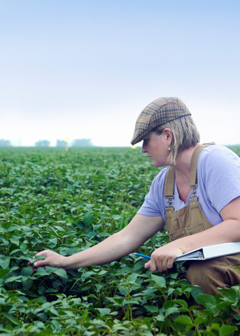What Farmers, Ranchers, and Other Agricultural Managers Do
About this section

Some farmers work primarily with crops and vegetables, whereas other farmers and ranchers handle livestock.
Farmers, ranchers, and other agricultural managers run establishments that produce crops, livestock, and dairy products.
Duties
Farmers, ranchers, and other agricultural managers typically do the following:
- Supervise all steps of crop production or ranging, including planting, fertilizing, harvesting, and herding
- Make decisions about crops or livestock by evaluating factors such as market conditions, disease, soil conditions, and the availability of federal programs
- Choose and buy supplies, such as seed, fertilizer, and farm machinery
- Maintain farming equipment
- Maintain farm facilities, such as water pipes, fences, and animal shelters
- Serve as the sales agent for crops, livestock, and dairy products
- Record financial, tax, production, and employee information
Farmers, ranchers, and other agricultural managers monitor the prices for their products. They use different strategies to protect themselves financially from unpredictable changes in the markets. For example, some farmers carefully plan the combination of crops they grow, so that if the price of one crop drops, they have enough income from another crop to make up for the loss. Farmers and ranchers also track disease and weather conditions, either or both of which may negatively impact crop yields or animal health. By planning ahead, farmers and ranchers may be able to store their crops or keep their livestock in order to take advantage of higher prices later in the year.
Some farmers choose to sell a portion of their goods directly to consumers through farmer’s markets or cooperatives to reduce their financial risk and to gain a larger share of the final price of their goods.
Farmers, ranchers, and other agricultural managers negotiate with banks and other credit lenders to get financing, because they must buy seed, livestock, and equipment before they have products to sell.
Farmers and ranchers run farms that are primarily family owned. Those who do not own the land themselves may lease it from a landowner to operate as a working farm.
The size of the farm or range determines which tasks farmers and ranchers handle. Those who run small farms or ranges may do all tasks, including harvesting and inspecting the land, growing crops, and raising animals. In addition, they keep records, service machinery, and maintain buildings.
By contrast, farmers and ranchers who run large farms generally hire others—including agricultural workers—to help with physical work. Some of the workers on large farms are in nonfarm occupations, such as truck drivers, sales representatives, bookkeepers, and information technology specialists.
Farmers and ranchers follow improvements in animal breeding methods and seed science, choosing products that may increase output. Livestock and dairy farmers monitor and attend to the health of their herds, which may include assisting in births.
Agricultural managers take care of the day-to-day operations of one or more farms, ranches, nurseries, timber tracts, greenhouses, and other agricultural establishments for corporations, farmers, and owners who do not live and work on their farm or ranch.
Agricultural managers usually do not participate directly in production activities. Instead, they hire and supervise farm and livestock workers to do most of the daily production tasks.
Managers may determine budgets and decide how to store, transport, and sell crops. They also may oversee the maintenance of equipment and property.
The following are examples of types of farmers, ranchers, and other agricultural managers:
Crop farmers and managers are responsible for all stages of plant growth, including planting, fertilizing, watering, and harvesting crops. These farmers may grow grain, fruits, vegetables, and other crops. After a harvest, they make sure that the crops are properly packaged and stored.
Livestock, dairy, and poultry farmers, ranchers, and managers feed and care for animals, such as cows or chickens, in order to harvest meat, milk, or eggs. They keep livestock and poultry in barns, pens, and other farm buildings. These workers also may oversee animal breeding in order to maintain appropriate herd or flock size.
Nursery and greenhouse managers oversee the production of trees, shrubs, flowers, and plants (including turf) used for landscaping. In addition to applying pesticides and fertilizers to help plants grow, they often are responsible for keeping track of marketing activity and inventory.
Aquaculture farmers and managers raise fish and shellfish in ponds, floating net pens, raceways, and recirculating systems. They stock, feed, and maintain aquatic life used for food and recreational fishing.
 United States Department of Labor
United States Department of Labor










